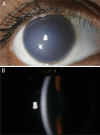Mutation analysis of the SLC4A11 gene in Indian families with congenital hereditary endothelial dystrophy 2 and a review of the literature
- PMID: 23922488
- PMCID: PMC3733908
Mutation analysis of the SLC4A11 gene in Indian families with congenital hereditary endothelial dystrophy 2 and a review of the literature
Abstract
Purpose: Congenital hereditary endothelial dystrophy 2 (CHED2) is an autosomal recessive disorder caused by mutations in the solute carrier family 4, sodium borate transporter, member 11 (SLC4A11) gene. The purpose of this study was to identify the genetic cause of CHED2 in six Indian families and catalog all known mutations in the SLC4A11 gene.
Methods: Peripheral blood samples were collected from individuals of the families with CHED2 and used in genomic DNA isolation. PCR primers were used to amplify the entire coding region including intron-exon junctions of SLC4A11. Amplicons were subsequently sequenced to identify the mutations.
Results: DNA sequence analysis of the six families identified four novel (viz., p.Thr262Ile, p.Gly417Arg, p.Cys611Arg, and p.His724Asp) mutations and one known p.Arg869His homozygous mutation in the SLC4A11 gene. The mutation p.Gly417Arg was identified in two families.
Conclusions: This study increases the mutation spectrum of the SLC4A11 gene. A review of the literature showed that the total number of mutations in the SLC4A11 gene described to date is 78. Most of the mutations are missense, followed by insertions-deletions. The present study will be helpful in genetic diagnosis of the families reported here.
Figures



Similar articles
-
Genetic analysis of two Indian families affected with congenital hereditary endothelial dystrophy: two novel mutations in SLC4A11.Mol Vis. 2007 Jan 16;13:39-46. Mol Vis. 2007. PMID: 17262014 Free PMC article.
-
Congenital hereditary endothelial dystrophy - mutation analysis of SLC4A11 and genotype-phenotype correlation in a North Indian patient cohort.Mol Vis. 2010 Dec 31;16:2955-63. Mol Vis. 2010. PMID: 21203343 Free PMC article.
-
Identification of mutations in the SLC4A11 gene in patients with recessive congenital hereditary endothelial dystrophy.Arch Ophthalmol. 2008 May;126(5):700-8. doi: 10.1001/archopht.126.5.700. Arch Ophthalmol. 2008. PMID: 18474783
-
SLC4A11 and the Pathophysiology of Congenital Hereditary Endothelial Dystrophy.Biomed Res Int. 2015;2015:475392. doi: 10.1155/2015/475392. Epub 2015 Sep 16. Biomed Res Int. 2015. PMID: 26451371 Free PMC article. Review.
-
Congenital hereditary endothelial dystrophy with progressive sensorineural deafness (Harboyan syndrome).Orphanet J Rare Dis. 2008 Oct 15;3:28. doi: 10.1186/1750-1172-3-28. Orphanet J Rare Dis. 2008. PMID: 18922146 Free PMC article. Review.
Cited by
-
Mutational analysis in sodium-borate cotransporter SLC4A11 in consanguineous families from Punjab, Pakistan.PLoS One. 2022 Aug 29;17(8):e0273685. doi: 10.1371/journal.pone.0273685. eCollection 2022. PLoS One. 2022. PMID: 36037197 Free PMC article.
-
Human Corneal Expression of SLC4A11, a Gene Mutated in Endothelial Corneal Dystrophies.Sci Rep. 2019 Jul 4;9(1):9681. doi: 10.1038/s41598-019-46094-y. Sci Rep. 2019. PMID: 31273259 Free PMC article.
-
Biosynthetic and functional defects in newly identified SLC4A11 mutants and absence of COL8A2 mutations in Fuchs endothelial corneal dystrophy.J Hum Genet. 2014 Aug;59(8):444-53. doi: 10.1038/jhg.2014.55. Epub 2014 Jul 10. J Hum Genet. 2014. PMID: 25007886
-
Exome Sequencing Reveals SLC4A11 Variant Underlying Congenital Hereditary Endothelial Dystrophy (CHED2) Misdiagnosed as Congenital Glaucoma.Genes (Basel). 2023 Jan 25;14(2):310. doi: 10.3390/genes14020310. Genes (Basel). 2023. PMID: 36833236 Free PMC article.
-
Structural insights into the conformational changes of BTR1/SLC4A11 in complex with PIP2.Nat Commun. 2023 Oct 3;14(1):6157. doi: 10.1038/s41467-023-41924-0. Nat Commun. 2023. PMID: 37788993 Free PMC article.
References
-
- Ehlers N, Módis L, Møller-Pedersen T. A morphological and functional study of congenital hereditary endothelial dystrophy. Acta Ophthalmol Scand. 1998;76:314–8. - PubMed
-
- Toma NM, Ebenezer ND, Inglehearn CF, Plant C, Ficker LA, Bhattacharya SS. Linkage of congenital hereditary endothelial dystrophy to chromosome 20. Hum Mol Genet. 1995;4:2395–8. - PubMed
-
- Hand CK, Harmon DL, Kennedy SM, FitzSimon JS, Collum LMT, Parfey NA. Localization of the gene for autosomal recessive congenital hereditary endothelial dystrophy (CHED2) to chromosome 20 by homozygosity mapping. Genomics. 1999;61:1–4. - PubMed
-
- Vithana EN, Morgan P, Sundaresan P, Ebenezer ND, Tan DT, Mohamed MD, Anand S, Khine KO, Venkataraman D, Yong VH, Salto-Tellez M, Venkatraman A, Guo K, Hemadevi B, Srinivasan M, Prajna V, Khine M, Casey JR, Inglehearn CF, Aung T. Mutations in sodium-borate cotransporter SLC4A11 cause recessive congenital hereditary endothelial dystrophy (CHED2). Nat Genet. 2006;38:755–7. - PubMed
-
- Romero MF. Molecular pathophysiology of SLC4 bicarbonate transporters. Curr Opin Nephrol Hypertens. 2005;14:495–501. - PubMed
Publication types
MeSH terms
Substances
LinkOut - more resources
Full Text Sources
